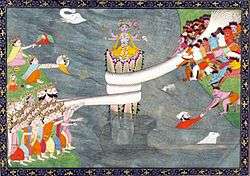Vasuki
Vāsuki is a serpent king in Hindu and Buddhist religion. He is described as having a gem called Nagamani on his head. Manasa, another naga, is his sister. Vāsuki is Shiva's snake. He is known in Chinese and Japanese mythology as being one of the "eight Great Dragon Kings" (八大龍王 pinyin: Bādà lóngwáng; Japanese: Hachidai Ryūō),[2] amongst Nanda (Nāgarāja), Upananda, Sāgara (Shakara), Takshaka, Balavan, Anavatapta and Utpala.
| Vāsuki | |
|---|---|
King of Sārpas[1] | |
 Kurma Avatar of Vishnu, below Mount Mandara, with Vasuki wrapped around it, during Samudra manthan, the churning of the ocean of milk. ca 1870 | |
| Affiliation | Nāga |
| Abode | Earth |
| Symbols | Nagamani |
| Personal information | |
| Parents | Kadru, Kashyap |
| Siblings | Manasa, Shesha |
Nagamani of narmatha
Vāsuki is famous for coiling around Shiva's neck, who blessed and wore him as an ornament.
Vāsuki took part in the incident of Samudra madanam by allowing both the devas and the asuras to bind him to Mount Mandara while Mount Mandaar or Mandar Hill or Mandar Parvat, as it is popularly known, is located in Banka District, in the State of Bihar in INDIA, the temple of Lord Shiva, called Vasukinath, literally meaning "the Lord of Vasuki", is just a few kilometres away from Mandar Parvat, in the State of Jharkhand, in Dumka District], so that they could use him as their churning rope to extract the amṛutam from the ocean of milk.[3] Vasuki is also mentioned in other Hindu scriptures, such as Ramayana and Mahabharata.
In the Buddhist mythology, Vāsuki and the other Nāga Kings appear in the audience for many of Gautama Buddha's sermons. The duties of the Nāga Kings included leading the nāgas in protecting and worshiping the Buddha, as well as protecting other enlightened beings.
Vāsuki's Naga priest is Tatig Naga.
Descendants
Vāsuka/Vāsuca (or Vāsuki) is the name of a Nair and pedireddla clan found near Mannarasala in Kerala and also Visakha district in Andhra Pradesh. They claim that their ancestors were Nāga serpents spared when the Khandava Forest (modern day Delhi) was burnt and cleared by Krishna and the Pandavas to make way for their capital Indraprastha.[4]
Bibliography
- Handa, Om Chanda (2004), Naga Cults and Traditions in the Western Himalaya, Indus Publishing, ISBN 978-8173871610CS1 maint: ref=harv (link)
References
- Handa 2004, p. 91.
- http://www.chinabuddhismencyclopedia.com/en/index.php/Eight_great_dragon_kings
- Jones, Constance (2007). Encyclopedia of Hinduism. New York: Infobase Publishing. p. 300. ISBN 0-8160-5458-4.
- Social History of Kerala: The Dravidians By L. A. Krishna Iyer p.003
- Cobra Pearl or Nagamani
- Dictionary of Hindu Lore and Legend (ISBN 0-500-51088-1) by Anna L. Dallapiccola
- Indian Mythology, by ApamNapat
- Nagas
- Stories from the Ramayana
- Hachi Bushu – The Eight Legions, Buddhist Protectors
- Dragon in China and Japan (ISBN 0-7661-5839-X) by M.W. De Visser
